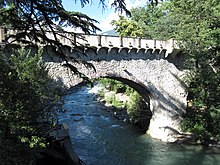| Revision as of 01:58, 16 January 2009 editIcsunonove (talk | contribs)2,418 editsmNo edit summary← Previous edit | Latest revision as of 20:53, 14 December 2024 edit undoJJMC89 bot III (talk | contribs)Bots, Administrators3,706,096 editsm Merging Category:Transport infrastructure completed in 1617 to Category:Buildings and structures completed in 1617 and Category:Transport infrastructure completed in the 1610s per Misplaced Pages:Categories for discussion/Log/2024 December 4 | ||
| (56 intermediate revisions by 25 users not shown) | |||
| Line 1: | Line 1: | ||
| ] | ] | ||
| ] | |||
| The '''Steinerner Steg''' ({{langx|it|Ponte Romano}}) is a two-arched, stone-built ] across the ] in ], ], northern Italy. The oldest bridge in the town, it connects the historic centre and the Steinach district with the Obermais quarter.<ref> {{in lang|it}} / {{in lang|de}}, website of the Municipality.</ref> | |||
| In 1615 the wooden aqueduct which spanned the river here had fallen into disrepair and the town decided to demolish it and build a stone bridge in its place. The following year Andrä Tanner, an architect from ], was contracted to build the replacement. Scarcely had the works been completed, however, when the new bridge was washed away in a flood. The current structure was completed in 1617.<ref name="Januth"> | |||
| The '''Steinerner Steg''' (] for "Stone bridge"; {{lang-it|Ponte Romano}}, which translates to "Roman bridge") is a ] across the ] river in ], ]. The bridge features two arches. It was built in 1616 according to the city's offical website.<ref></ref> The city council further provides a completion date of 1617, as well as the name of the architect, Andrä Tanner of ], who was contracted to replace an earlier wooden bridge demolished in 1615.<ref></ref> | |||
| {{citation|url=http://www.comune.merano.bz.it/upload/beschluesse/doc/del_gr/051_2_69k_2008.pdf | |||
| |first=Günther|last=Januth|title=Written responses given by the mayor of Meran to various questions from councillors|publisher=Stadtgemeinde Meran / Comune di Merano|year=2008|language=it}}. See section 20.</ref> The bridge is in close proximity to the ''Passeirer Tor'', one of the ]. | |||
| __NOTOC__ | |||
| == |
==Naming== | ||
| “Steinerner Steg” is simply ] name for “stone footbridge”, while “Ponte Romano” is the ] equivalent of “Roman bridge”. Although the latter name has been taken to imply that the bridge might have ancient Roman origins, but in fact “Ponte Romano” was only introduced on December 2, 1927 by the ] as part of their ].<ref name="Januth"/> | |||
| == Notes == | |||
| In O'Connor's study of Roman bridges, he came to the conclusion that the Italian name may have originated from indications of an earlier ] bridge or structure.<ref>Colin O'Connor, Roman Bridges, Cambridge University Press (1994) ISBN 0-521-39326-4, p.95</ref> However, the mayor of Merano, Günther Januth, made a statement in 2008 that suggests the name was a remnant of fascist-era Italianization. | |||
| {{reflist}} | |||
| == Further reading == | |||
| ==References== | |||
| * {{citation|first=Cölestin|last=Stampfer|title=Geschichte von Meran, der alten Hauptstadt des Landes Tirol|place=Innsbruck|year=1889|isbn=3-500-30390-0|page=118}} | |||
| <references/> | |||
| == External links == | |||
| {{Commons| |
{{Commons category-inline|Steinerner Steg (Meran)|Steinerner Steg}} | ||
| {{Authority control}} | |||
| {{coord missing|Italy}} | |||
| {{coord|46|40|18|N|11|10|09|E|region:IT-32_type:landmark_source:kolossus-dewiki|display=title}} | |||
| ] | ] | ||
| ] | ] | ||
| ] | |||
| ] | |||
| {{bridge-struct-stub}} | |||
| ] | |||
| {{Italy-struct-stub}} | |||
| ] | |||
| ] | |||
| ] | |||
| ] | |||
| ] | |||
| ] | |||
| ] | |||
Latest revision as of 20:53, 14 December 2024


The Steinerner Steg (Italian: Ponte Romano) is a two-arched, stone-built footbridge across the Passer in Merano, South Tyrol, northern Italy. The oldest bridge in the town, it connects the historic centre and the Steinach district with the Obermais quarter.
In 1615 the wooden aqueduct which spanned the river here had fallen into disrepair and the town decided to demolish it and build a stone bridge in its place. The following year Andrä Tanner, an architect from Brixen, was contracted to build the replacement. Scarcely had the works been completed, however, when the new bridge was washed away in a flood. The current structure was completed in 1617. The bridge is in close proximity to the Passeirer Tor, one of the town gates of Merano.
Naming
“Steinerner Steg” is simply German name for “stone footbridge”, while “Ponte Romano” is the Italian equivalent of “Roman bridge”. Although the latter name has been taken to imply that the bridge might have ancient Roman origins, but in fact “Ponte Romano” was only introduced on December 2, 1927 by the fascist authorities as part of their Italianization of South Tyrol campaign.
Notes
- Attrazioni (in Italian) / Sehenswürdigkeiten (in German), website of the Municipality.
- ^ Januth, Günther (2008), Written responses given by the mayor of Meran to various questions from councillors (PDF) (in Italian), Stadtgemeinde Meran / Comune di Merano. See section 20.
Further reading
- Stampfer, Cölestin (1889), Geschichte von Meran, der alten Hauptstadt des Landes Tirol, Innsbruck, p. 118, ISBN 3-500-30390-0
{{citation}}: CS1 maint: location missing publisher (link)
External links
![]() Media related to Steinerner Steg at Wikimedia Commons
Media related to Steinerner Steg at Wikimedia Commons
46°40′18″N 11°10′09″E / 46.67167°N 11.16917°E / 46.67167; 11.16917
Categories:- Bridges in Italy
- Stone bridges in Italy
- Buildings and structures in South Tyrol
- Merano
- Transport in South Tyrol
- Bridges completed in the 17th century
- Buildings and structures completed in 1617
- Transport infrastructure completed in the 1610s
- 1617 establishments in the Holy Roman Empire
- Stone arch bridges
- 1617 establishments in Italy